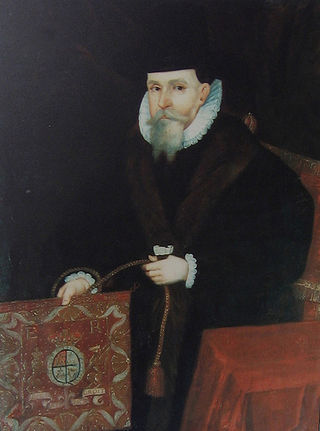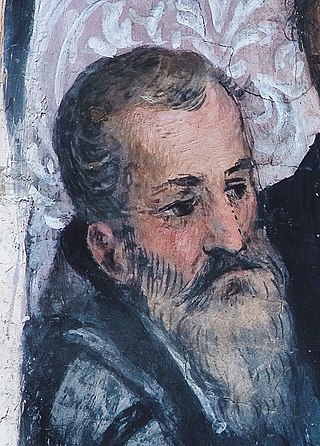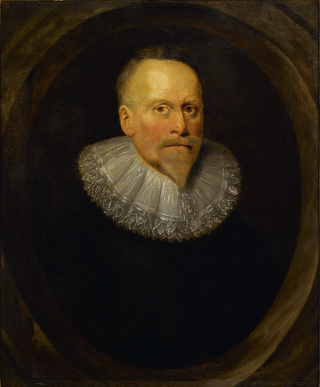
Adam Loftus was an English Roman Catholic priest from North Yorkshire who conformed to Anglicanism following the ascension to the throne of Queen Elizabeth I of England. Loftus subsequently served as Church of Ireland Archbishop of Armagh, Archbishop of Dublin, and Lord Chancellor of Ireland from 1581. Loftus is particularly important to Irish history as the founder and first Provost of Trinity College Dublin and for his central role in the 1584 torture and execution of Archbishop Dermot O'Hurley, who was Beatified by Pope John Paul II as one of the Irish Catholic Martyrs in 1992. Loftus is also notable, through the marriage of his daughter Anne to the son and heir of Sir Henry Colley and their subsequent issue, as the ancestor of Arthur Wellesley, 1st Duke of Wellington.

Hugh O'Neill, Earl of Tyrone was a Gaelic Irish lord and key figure of the Nine Years' War. Known as the "Great Earl", he led the confederacy of Irish clans against the English Crown in resistance to the Tudor conquest of Ireland under Queen Elizabeth I.
Sir Walter Butler, 11th Earl of Ormond and 4th Earl of Ossory (1559–1633), succeeded his uncle Black Tom, the 10th earl, in 1614. He was called "Walter of the Beads" because he was a devout Catholic, whereas his uncle had been a Protestant. King James I intervened and awarded most of the inheritance to his uncle's Protestant daughter Elizabeth. Ormond contested the King's decision and was for that insolence detained in the Fleet Prison from 1619 until 1625 when he submitted to the King's ruling. He then found a means to reunite the Ormond estate, by marrying his grandson James, who had been raised a Protestant, to Elizabeth's only daughter.
Sir Henry Bagenal PC was marshal of the Royal Irish Army during the reign of Queen Elizabeth I.

Thomas Jones was Archbishop of Dublin and Lord Chancellor of Ireland. He was also Dean of St. Patrick's Cathedral and Bishop of Meath. He was the patrilineal ancestor of the Viscounts Ranelagh.

Henry Loftus, 1st Earl of Ely KP, PC (Ire), styled The Honourable from 1751 to 1769 and known as Henry Loftus, 4th Viscount Loftus from 1769 to 1771, was an Anglo-Irish peer and politician.

Sir Nicholas Bagenal was an English soldier and politician who became Marshal of the Irish Army during the Tudor era.
Dominick Sarsfield, 1st Viscount Sarsfield of Kilmallock was an Irish peer and judge who became Chief Justice of the Irish Common Pleas, but was removed from office for corruption and died in disgrace.
Nicholas Barnewall, 1st Viscount Barnewall of Turvey, County Dublin, was an Irish landowner and politician.
Sir Patrick Barnewall or Barnwall, was the eldest son of Sir Christopher Barnewall of Turvey House, Grace Dieu Abbey, and Fieldston. Christopher in turn was the son of the elder Sir Patrick Barnewall, who in 1534 was made Serjeant-at-law (Ireland) and Solicitor-General for Ireland, and in 1550 became Master of the Rolls in Ireland. Patrick's mother was Marion Sherle, daughter of Richard Sherle of Shallon, County Meath: after his father's death, she remarried the prominent judge Sir Lucas Dillon. She died in 1607.
Sir Gerard Lowther, sometimes referred to as Gerald Lowther, was a member of the well-known Lowther family of Westmoreland. He had a distinguished judicial career in Ireland, becoming Chief Justice of the Irish Common Pleas, although his enemies claimed his success was due to a complete lack of moral principles.
Sir William Warren was an Irish landowner, statesman and soldier of the late sixteenth century. He is mainly remembered now for having facilitated the much-discussed marriage of Hugh O'Neill, Earl of Tyrone and his third wife Mabel Bagenal, which took place at Warren's home, Drumcondra Castle, in 1591.
Charles Moore, 2nd Viscount Moore of Drogheda (1603-1643) was an Irish aristocrat noted for his leadership of Irish Royalist forces in northern Leinster during the early stages of the Irish Confederate Wars.
Ellis MacDonnell, Countess of Antrim was an Irish aristocrat of the late Elizabethan and early Stuart eras.
Dudley Bagenal (1554–1587) was an Irish soldier and landowner of the Tudor era.
Nicholas Loftus (1592-1666) was an Irish politician and public official.
Patrick Sarsfield was an Irish landowner and soldier of the seventeenth century noted for his role in the Irish Confederate Wars. He is best known as the father of Patrick Sarsfield, 1st Earl of Lucan, and is sometimes referred to as Patrick Sarsfield the Elder because of this.
Mabel O'Neill, Countess of Tyrone was an Anglo-Irish noblewoman best known as the third wife of prominent Gaelic Irish lord Hugh O'Neill, Earl of Tyrone.
Sir Lawrence Parsons was an English-born barrister, judge and politician in seventeenth-century Ireland, who enjoyed a highly successful career, despite frequent accusations of corruption and neglect of official duty. His success owed much to the patronage of his uncle Sir Geoffrey Fenton, of his cousin by marriage Richard Boyle, 1st Earl of Cork, and of the prime Royal favourite, the Duke of Buckingham. He was the ancestor of the Earl of Rosse of the second creation. He rebuilt Birr Castle, which is still the Parsons family home.
Siobhán O'Neill, Countess of Tyrone, sometimes anglicised Joanna, Joan, or Judith, was a sixteenth-century Irish Gaelic noblewoman of the O'Donnell clan. She was the second wife of Hugh O'Neill, Earl of Tyrone, bearing him most of his children.




